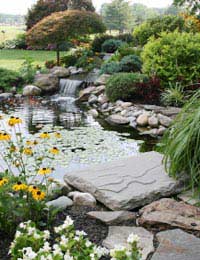
Although the deliberate isolation of some types of water features – raised or formal ponds, for instance – is what gives them their impact, for many gardeners the pond is intended to provide a complementary element in the overall design. The key to making the pond form an integral part of the garden principally lies in carefully landscaping the join between water and dry land.
Setting the Scene with Hard Landscaping
Many of the hard landscaping decisions will have been made when the pond was first created. If you built it yourself, you will have already had a chance to influence aspects such as the edging, the general location, shape and surrounding contours; if you inherited it from a previous owner your options will obviously have been more limited. Even so, if aspects of the pond and its setting are not to your liking, it can often be possible to change things to some extent – so it’s definitely worth giving it some consideration as part of the whole landscaping process. Creating undulations or banks, adding “focal pieces” such as rocks or overhanging logs can transform the look of a pond – and you might like to think about adding a fountain or waterfall if there isn’t one already. Although not strictly a landscaping job, fitting some form of lighting – either solar or mains-powered – can also do a lot to change the feel of the pond.
Planting the Margins
While the hard landscaping elements inevitably define much of the overall appearance, a good planting scheme can prove a very effective way to help the pond merge almost seamlessly into its surroundings. Wisely chosen and imaginatively used around the margins of your pond, the effect can soften the stark lines of the pond, allowing it to look as if it has always been there.
In nature, marginal plants grow with their roots in the shallow water and most pre-moulded ponds have suitably designed shelves to take planting containers to accommodate them. These plants are particularly useful for landscaping the pond margins because they begin to introduce a feeling of height and start to lift the eye up out of the water and towards the rest of the garden in a way that looks entirely natural. Selecting different types of marginals allows you to play with this idea even more, providing a succession, gradually getting taller and taller until they eventually meet the plants surrounding the pond. This can be particularly effective if the pond has a relatively wide marginal shelf, but even if it is quite narrow, the trick is still worth trying.
Most garden centres have a good selection ranging from the likes of the low growing Water Mint (Mentha aquatic) through taller plants such as Marsh Marigold (Caltha palustris) to much taller candidates including Yellow flag (Iris pseudocorus ).
The location of the pond and how you intend it to be viewed obviously affects the planting around it, but it can be very effective to have at least a part of the area bordering it – perhaps to one side – made into a bog garden. Bog plants are an amazingly diverse bunch and although their flowering season is usually fairly short, they offer considerable variety of form, colour and size, so there is sure to be a big enough choice to satisfy the tastes of any gardener.
Once you get beyond the sodden limits of the bog area, the choice of planting is really as wide as you choose to make it and provides the final bridge into the rest of the garden itself. If you choose to use some tall marginals and bog plants, picking some still taller specimens to form a backdrop can be one very effective way of showing them off to the full. It is also well worth remembering that the pond plants will be dormant throughout winter and early spring making it a good idea to try to ensure that there will be some point of interest year-round. Working with the possibilities reflections offer can be interesting too. Although planting Azaleas beside a pond is often seen as somewhat done-to-death, nevertheless, there is a reason why it has been repeated so often; it works! However, if you really can’t bring yourself to do it, there are plenty of other plants with colourful foliage or striking blooms that will work just as well.
A pond can make a tremendous contribution to any garden – especially if it fits in and looks right. With a good planting scheme and a little imagination, it is not too difficult to get that crucial join between the two to work – and is certainly worth the effort.
Last Modified: January 25, 2022








What cement would you recommend to place stones around and in a wildlife pond? Also you mention sealant, how is this applied? Thank you
@mickey. Any cement will do and the sealant should be specific pond/concrete waterproof sealer. Ask your local aquatic trader for advice.